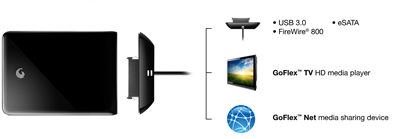The Serial ATA International Organization (Sata-IO) announced the Universal Storage Module (USM) standard at CES 2011. This standard mainly defines mechanical characteristics and some electrical specs for hard drives so that they can be connected to devices (PC, laptops, tablets, televisions, media players, set-top boxes…) via a slot without the need to have an extra cable. This also allows a SATA harddisk to be used as a USB harddrive via a standard adapter. Later on this will also support other connection standards such as Firewire. The specifications will only support 2.5″ HDD, not the larger 3.5″. Those specifications are not publicly available yet (Target: 1H 2011) since they are still developing them. In the mean time you can check the FAQ (below) and have a look a the USM presentation slides.
 Seagate showcased their GoFlex design based on the USM specs where you can see the forum factor of the SATA drive (that will be inserted in a slot) and a compatible USB to SATA connector that can be plugged in. They also introduced Seagate Momentus XT Hybrid Hard Drive
Seagate showcased their GoFlex design based on the USM specs where you can see the forum factor of the SATA drive (that will be inserted in a slot) and a compatible USB to SATA connector that can be plugged in. They also introduced Seagate Momentus XT Hybrid Hard Drive. This hard disk embeds both a 4GB SSD and a traditional mechanical hard drive (e.g. 320GB, 500GB). The 4GB SSD would be used to store the OS and programs in order to speed up the boot time. The standard hard disk allows a cheaper price (compared to SSD) to store your data. Have a look at the video interview with Seagate at CES 2011 below.
For further info here’s the USM FAQ:
- What is the USM specification?
The SATA Universal Storage Module (USM) specification allows developers to incorporate slots into televisions, game consoles, set-top boxes, computers, docking stations and other computer electronics applications that will accept powered, cable free storage modules with integrated SATA interfaces for expanded external storage capacity. Devices based on the specification are particularly well-suited for audio/video streaming and other consumer electronics applications.- How do devices based on the USM specification work?
Modules based on the USM specification build a standard SATA interface into a robust data module that can be plugged in to devices like TVs, game consoles, set-top boxes, desktop and notebook computers, and other consumer electronics applications to provide additional storage. CE devices based on the USM specification feature slots that accept USM modules.- What does the USM specification define?
The USM specification defines how the SATA interface is integrated into a module form factor, and how power is provided to the interface. A complementary specification under development in the Small Form Factor Committee (SFF) defines the form factor and size requirements for USM products.- What benefits do devices based on the USM specification provide?
Devices based on the USM specification extend the speed and reliability of Serial ATA technology from the PC storage space to a variety of consumer electronics applications like televisions, game consoles and set-top boxes, as well as desktop and notebook computers. Additionally, USM devices are the first products to provide a portable, 6Gb/s powered SATA solution for consumer applications, enabling consumers to instantly access movies, music and other content, and to transfer content between devices
without having to carry a cable, connector or power supply.- What transfer rates does the USM Specification support?
The USM specification supports the current SATA data rate of 6Gb/s. Devices based on the specification will also be able to degrade their speed for compatibility with products
designed to previous generation SATA specifications.- Do devices based on the USM specification require any additional cables or equipment?
No. Because the USM specification integrates the SATA interface into a module form factor, USM modules can simply be plugged in to host devices in order to deliver additional storage capacity.- When can we expect the USM specification to be available?
The USM specification is currently under development within the Serial ATA International Organization (SATA-IO). SATA-IO expects the specification to be completed and available later this year.- Does the USM specification address content protection?
No. The USM specification defines how the SATA interface is integrated into a module form factor. Implementation of content protection technologies will be addressed by individual device manufacturers whose products support the standard.

Jean-Luc started CNX Software in 2010 as a part-time endeavor, before quitting his job as a software engineering manager, and starting to write daily news, and reviews full time later in 2011.
Support CNX Software! Donate via cryptocurrencies, become a Patron on Patreon, or purchase goods on Amazon or Aliexpress




